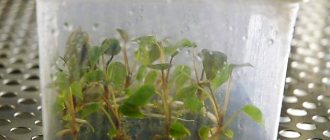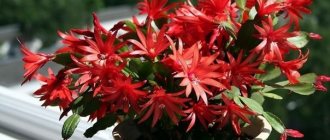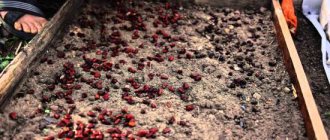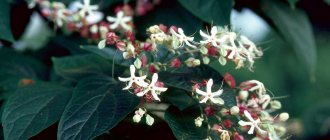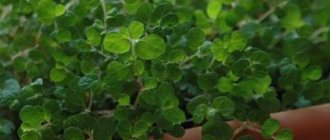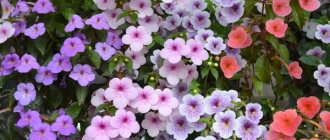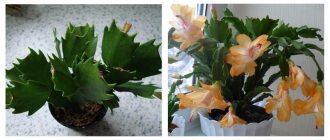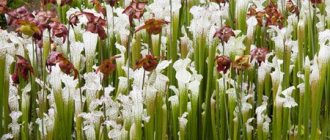Mrs. Thompson's clerodendrum is one of 450 species of clerodendrum that exist in the world.
This is a vine with flexible intertwining branches, reaching a length of four meters. Belongs to plants of a deciduous variety, the Verbenaceae family. It is native to Africa, Australia, Asia, mainly in the tropics and subtropics. The second name in translation means “tree of fate”: “Cleros” is translated as “holy”, and “dendron” as “tree”. Clerodendrum Thompson is a very beautiful perennial tropical variegated indoor flower. The dark green leaves have an oval-quilted shape and grow up to twelve centimeters. The edges of the leaflets are smooth. The pointed tip and pronounced veins of the leaves are a feature of the flower. The shoots are densely leafy. The stems become woody as the plant matures.
Biological characteristics
Thompson's clerodendrum (Clerodendrum Thomsoniae) is a species of flowering vine from the genus Clerodendrum, family Verbenaceae. It is an evergreen plant that can reach up to 4 m in height. Its leaves are bright green, oblong, up to 17 cm long, on average 13-14 cm with pronounced veins. Five-petalled flowers up to 2.5 cm in diameter are formed in racemes of 8 to 20 pieces. on one in sympodial inflorescences. The color ranges from pure white to lilac and crimson shades. The corolla is red with 5 petals and 2 cm long.
Clerodendrum Thompson
Plant name
Translated from Greek “Kleros” means “fate, lot, luck”, and “Dendron” means “tree”. The flower has many names: bleeding glory, bleeding heart grape, runflower, but these names can also be applied to the other 400 species of the genus Clerodendrum.
Where the name comes from is not entirely known. There are several versions:
- In the 19th century. lived a Scottish missionary D. Thompson, who came to Cameroon to collect a collection of flowers for the Royal Botanic Gardens at Kew and the British Museum.
- George had a nephew, W. Cooper Thompson, who was also a missionary, but in Nigeria, and it was in his honor that the plant was named (originally Bleeding Heart, later renamed Clerodendrum Thompson).
- William was married, and after his wife died, he asked to name a flower in her honor. Therefore, you can sometimes hear the name Mrs. Thompson's clerodendrum.
In general, there is no exact version, but it is clear that the name revolves around one family of missionaries.
Note! The genus of plants is very rich, but mainly clerodendrum Mehonsol, Thompson, Wallich, Ugandan, Philippine, speciosum, tripartite and Bunge are grown.
Natural habitat
The plant was brought from western Africa, more precisely from Cameroon west to Senegal. In some regions it was never possible to cultivate it, so it is naturalized.
Description and features
In nature, Thompson's clerodendrum vines stretch up to 4 m. This is facilitated by a warm climate without strong temperature fluctuations, high humidity, and an optimal amount of sunlight. In apartments, growth is limited artificially - by pruning and pinching.
Thompson's clerodendrum blooms with small flowers of five petals surrounded by voluminous bracts. Flowers are collected in axillary racemes. The foliage is also very decorative. The color of the leaves is predominantly dark green. There are varieties with variegated and purple leaves. A special feature of clerodendrum is the “quilted” texture of the leaf surface due to deep, clearly defined veins.
Thompson's clerodendrum blooms towards mid-spring and ends blooming in autumn. Depending on the variety, flowers and bracts can be of different shades. The whisks don't last long. After they fall off, beautiful bracts of white, burgundy, pink or lilac hue remain on the bush. The fruits are small and orange. Each fruit contains one seed. The seeds are suitable for propagation.
You can form Thompson's clerodendrum in different ways - let it grow on supports in the form of a vine, trim it regularly to obtain a neat, lush bush. Some gardeners form an original standard tree from clerodendrum.
Clerodendrum Thompson: home care
Bouvardia flower: home care and methods of propagation
Clerodendrum Thompson is one of the few species of the genus Clerodendrum that can take root at home. However, for this to happen, certain conditions must be met.
Correct lighting
Clerodendrum needs a lot of light; direct sunlight will not damage the flower. Therefore, the plant gets along well on the eastern, southern and western sides. However, in the north it may not have enough light to form buds.
Clerodendrum Thomsoniae
Watering and fertilizing regime for flowering
The plant must be watered regularly and abundantly (especially in spring and summer), since clerodendrum loves moisture.
Important! It is necessary to water after the top layer of soil has dried. Clerodendrum does not like both drought and flooding. In winter, the plant stops growing and absorbs little water, so during this period it is important to ensure that there is no excess water. You can water with running, settled water at room temperature.
The plant will also feel good with regular spraying, especially in the summer when it is very hot or if there are powerful radiators or heaters in the room. Otherwise, the leaves will turn yellow and the plant will dry out.
In winter (during dormancy), the vine can simply shed its leaves. If this happens, do not worry and try to increase the humidity. This is a natural process. Although it would be a good idea to protect the flower from direct hot air.
Note! During the active growth phase (spring-summer), the plant needs to be fertilized with liquid fertilizer for beautifully flowering indoor plants. This needs to be done regularly: every week. In the fall, 1-2 times a month is enough; in the winter, you don’t need to do this at all.
What you need for abundant flowering. Signs and superstitions
In unfavorable conditions, Thompson's clerodendrum does not bloom. The most common mistake novice gardeners make is neglecting the winter dormant phase. In warm weather, flower buds do not form and flower stalks do not appear in spring. In winter, the flower should be kept in a cool room. In total, there are three reasons for the lack of flowering:
- warm winter;
- improper or insufficient pruning;
- lack of nutrients (potassium and phosphorus).
To make Thompson's clerodendrum bloom, at the end of autumn it is moved to a cool room and watering is limited. The soil should be slightly moist. You can prune in the fall before the dormant period or in early spring before active growth begins. In spring, clerodendrum is returned to warmth and watering is increased. After the first buds appear, mineral fertilizers begin to be applied.
Flowers form on new shoots, so in spring or autumn all clerodendrum lashes are cut off by a third. Without pruning, cold wintering and regular replanting, clerodendrum will not bloom.
Caring for Thompson's clerodendrum during flowering involves systematic watering and fertilizing. The flower is protected from cold and drafts, temperature changes, and drying out of the soil. Withered flowers that have lost their decorative effect are immediately removed.
How to propagate Clerodendrum Thompson vine at home
Medinilla flower: home care and propagation methods
The liana can be propagated in two ways: cuttings and seeds.
Cuttings
To do this, you need to cut the stem, semi-lignified cuttings about 8-10 cm long and remove the lower pair of leaves.
Clerodendrum sprouts
Afterwards you need to prepare the soil mixture. It should consist of peat soil and perlite (or coarse sand). Mix in proportions of 1:1. Plant, cover with plastic wrap and place in a well-lit place with a temperature of 20-21°C.
Note! It is necessary to maintain constant soil moisture, otherwise the plant will not take root.
If everything is done correctly, then in about 4-6 weeks it will be possible to transplant the sprouts. The pots should be filled with compost soil. When transplanting, the container should not be large.
During this stage, it is also necessary to carry out the procedure of pinching the tips of the shoots to encourage the flower to tiller. After it grows a little, it will be possible to transplant it into wider containers.
Seeds
It is necessary to collect seeds from the mother plant when the flower is withered and the seeds are hard and dark in color. The soil needed is the same as for cuttings, then make a greenhouse. Here you need to especially carefully monitor temperature, humidity and lighting, because the seeds are much weaker than the cuttings and therefore may not germinate. In about 7-10 days, seedlings will be visible if everything is done correctly. After 6-8 weeks the plant can be planted in a large pot.
Seeds of the mother plant
Even if reproduction does not occur, it is necessary to replant both young and adult plants. The former need to be replanted every year, increasing the pot, and the latter - once every 2-3 years. The pot does not need to be changed, but it is important to replace the soil. This is done in the spring before the active growth stage.
Soil for clerodendrum Thompson
The soil for good growth of clerodendrum should be:
- nutritious, otherwise the clerodendrum will lack minerals for growth and vegetation;
- slightly acidic, otherwise the plant will rot;
- light.
You can either buy ready-made mixtures (for roses and azaleas, mix in a 4:1 ratio) or prepare them yourself. To do this, you will need sand, peat, humus, leaf and turf soil in equal quantities. At the bottom you need to lay out a good layer of expanded clay or broken brick.
When and how to replant?
When growing Thompson clerodendrum, it is necessary to annually replace the old soil mixture with a new one. The procedure is performed after pruning, when shoots actively begin to grow. Young specimens need annual replanting, while older vines are replanted after two to three years or the top layer of soil is renewed.
Nutritious soil with a low acidity level (pH 5-6) is suitable for clerodendrum. You can use a store-bought soil substrate and add sand to it, or prepare a soil mixture yourself. To do this, mix clay and leaf soil, peat and coarse sand in equal parts. Before use, the soil must be disinfected: heated in a hot oven, steamed or in the microwave.
A step-by-step transplant is a sequence of actions:
- Take a pot 2 cm wider and deeper than the previous one.
- Place drainage at the bottom with a 3 cm layer of small pebbles, broken bricks or expanded clay.
- They are replanted using the transfer method: they take the plant out of the old container along with a lump of earth and place it in a prepared flowerpot.
- Add new soil mixture, filling the voids and water.
- If a flower needs support, it is installed during replanting so that later, fixing it in the ground, does not damage the root system.
You should not take a pot that is too large, the plant does not have time to use the nutrients, and the soil becomes sour.
I do not replant flowers growing in large containers. They only replace the top layer of soil.
Bush formation
Gloriosa flower: home care and planting examples
Forming a bush is a very interesting procedure, and Thompson's clerodendrum is well suited for this. It can be grown as an ampel flower, or you can, for example, grow it around the perimeter that the plant owner himself wants. That is, you can make some kind of frame and grow along it, or around the room, or in any other shape.
Note! It is also possible to give it a racemose shape or a standard tree using formative pruning.
Diseases and pests
The main cause of plant disease is improper care . Withering or falling leaves indicates a lack or excess of watering. Also, the cause may be too dry air or low-nutrient soil without useful minerals.
Why doesn't Clerodendrum Thompson bloom? The answer is simple. The lack of flowering indicates improper wintering with too high temperatures. The cause may also be a lack of light, improper crown formation, or infrequent feeding.
If amber-brown streaks appear on the leaves, then the clerodendrum must be removed from direct sun to avoid further burns.
, spider mites or whiteflies may appear At the first symptoms, wipe the leaves of the plant with a napkin and soapy water. Then rinse under running warm water.
Why does Thompson's clerodendrum not bloom?
Clerodendrum may not bloom because it does not have enough light, nutrients and water. In general, artificial conditions are not so close to natural ones. Therefore, you need to monitor vital characteristics for clerodendrum. You can also carry out the following operation: after the crown has formed (somewhere in February), you need to leave the shoots (about 60 cm in length), and cut off the leaves. At the end of March - beginning of April the first flowers will appear. But for this procedure the plant must be an adult.
Lush green flower
Clerodendrum Thompson needs to arrange conditions that are as close to natural as possible in order to obtain flowering and proper flower development. However, this will not require a lot of time and effort. Clerodendrum Thomsoniae is an interesting, not very fussy plant that is easy to care for and will delight the residents of the house with its appearance.
Planting and propagation
Cuttings for propagation of Thompson's clerodendrum are simpler, faster and more familiar, and the shoots can be left after pruning. They quickly take root in water and after that you can plant them in pots with a diameter of 6 cm. At first, cover the young seedlings with a cap to create the effect of a mini-greenhouse until the first strong shoots appear.
But you can also use seeds: they are sown by mid-March in a mixture of soil, peat, sand and water. After this, it is important to ensure stable humidity, temperature and lighting. Therefore, this technology is not entirely convenient in an apartment - it is more like a greenhouse or greenhouse option.
After 1-1.5 months, seedlings appear, which soon stretch into bright green leaves. After this, the seedlings must be planted or planted in the same flowerpots with a diameter of 6 cm. Further care is the same as for adult Thompson clerodendrums.
A young growing plant needs to be replanted as the diameter of the pot increases. For adult clerodendrums, it is enough to replant them every few years in the same flowerpot to renew the soil and trim the rhizome.
By cuttings
For propagation by cuttings, you can use the apical stems that remain after pruning. They should have at least 3-4 internodes. Rooting the plant is very simple and quick. The plant can be rooted either in a container with water or in a moist substrate.
How to propagate clerodendrum from cuttings:
- Plant the cuttings remaining after pruning in a plastic cup with substrate;
- Cover with a mini-greenhouse made of cellophane or a bottle;
- Place in a well-lit place;
- Ventilate from time to time to prevent fungus from forming.
After 30-60 days, new leaves should appear on the seedlings. After complete rooting, the flower is transplanted into large containers.
Seeds
After the plant has flowered, small fruits form on it. Each of them contains one seed. Seeds are collected and sown in prepared containers with fortified soil. The planting is covered with a mini-greenhouse made from a glass jar or transparent cup.
Periodically, future seedlings are ventilated . After 45-60 days, sprouts should appear. Once they have leaves, they can be transplanted into larger containers. If the planting is additionally illuminated with artificial light, the sprouts will appear earlier - in 10-15 days.


